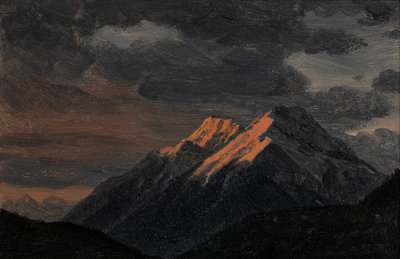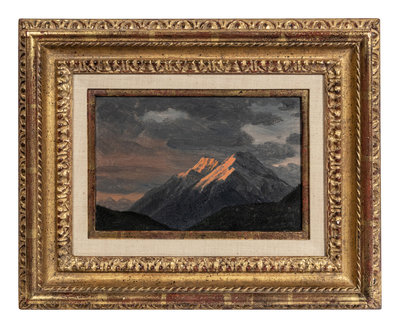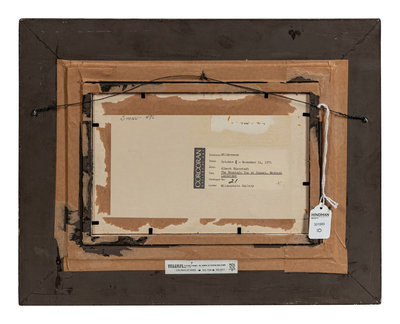Albert Bierstadt
(German/American, 1830-1902)
The Mountain Top at Sunset, Western Landscape
Sale 1092 - Western & Contemporary Native American Art
Nov 1, 2022
10:00AM MT
Live / Denver
Estimate
$8,000 -
$12,000
Sold for $25,000
Sold prices are inclusive of Buyer’s Premium
Lot Description
Albert Bierstadt
(German/American, 1830-1902)
The Mountain Top at Sunset, Western Landscape
card laid to paper
6 1/2 x 10 inches
Property from the Collection of Leonard and Joan Horvitz, Moreland Hills, Ohio
Provenance:
Wildenstein & Co. Inc., New York, New York
Exhibited:
Corcoran Gallery of Art, Washington, D.C., "Wilderness," October - November, 1971. Catalogue no. 21.
This painting is included in Melissa Speidel’s catalogue raisonné database of the artist’s works. It is accompanied by a letter of opinion from Melissa Speidel, issued September 18, 2022.
To begin to penetrate a painting such as Albert Bierstadt’s The Mountaintop at Sunset, Western Landscape, you ought to have some understanding of the 19th-century fascination—mania is not too strong a word—for mountains. British art critic John Ruskin’s (1819-1900) essays on mountains and rock forms is a good place to start, as is the recent book by naturalist and cultural historian Robert Macfarlane, Mountains of the Mind. Prior to the close of the 18th century, mountains were a locus of fear in the human imagination. Mountains were harsh and hostile. Gods lived there, death dwelled there, and the forbidding conditions coalesced into myths of monsters—giants, troll, wild men. But as the science of geology peeled back some of the truths about mountains—that they were formed and eroded over eons of deep time, that fossils on their summits revealed that some of them had once been the floors of oceans, that the ice in their never-melting glaciers seemed almost alive—they became objects of desire and exploration. Guided parties, with proper climbing costumes and gear, ascended peaks from well-appointed inns and lodges that sprang up at their bases. Amateur scientists became serious scientists, uncovering and publishing their findings. The Old Testament fear of mountains gave way to a New Testament vision of mountains as emblems of divine beauty and libraries of the stories of the Earth. In that spirit, The Mountaintop at Sunset, Western Landscape, with its fiery light falling like a spotlight on two snowy crests, emerges as a dispensation, a moment Bierstadt—who loved to roam and paint mountains—seems to feel he was permitted to see and share through his art. The brooding peaks are like old men who keep their wisdom close until the light finds them and reveals their million-year long conversation.
Albert Bierstadt was born near Dusseldorf but emigrated with his family to the bustling whaling town of New Bedford, Massachusetts. An early aptitude for art led to formal training back in Dusseldorf, a center of German Romanticism—Goethe, Beethoven, Wagner, and the surreal, majestic landscapes of Caspar David Fredrich. Bierstadt returned to the States, where Emerson, Cooper, Melville, and the Hudson River School painters were transforming the American landscape into a kind of philosophical consciousness through art and letters. In 1859, Bierstadt traveled with the Lander Expedition to the Rocky Mountains, where he found the inspiration he sought. Quick success once he returned to New York was tempered by the Civil War but the flock of artists and immigrants who headed west in his wake were inspired, in part, by his panoramic landscapes that combined elements of the beautiful and the sublime.
- James D. Balestrieri
- James D. Balestrieri
Condition Report
Overall good and stable condition. Does not fluoresce under UV light. Card fully affixed to thick paper support - unable to inspect verso. Minimal paint loss at edges, commensurate with framing. No other detected damage, losses, repairs or inpainting. Framed dimensions: 14 x 17 1/2 inches.
The physical condition of lots in our auctions can vary due to
age, normal wear and tear, previous damage, and
restoration/repair. All lots are sold "AS IS," in the condition
they are in at the time of the auction, and we and the seller make
no representation or warranty and assume no liability of any kind
as to a lot's condition. Any reference to condition in a catalogue
description or a condition report shall not amount to a full
accounting of condition. Condition reports prepared by Hindman
staff are provided as a convenience and may be requested from the
Department prior to bidding.
The absence of a posted condition report on the Hindman website or
in our catalogues should not be interpreted as commentary on an
item's condition. Prospective buyers are responsible for
inspecting a lot or sending their agent or conservator to inspect
the lot on their behalf, and for ensuring that they have
requested, received and understood any condition report provided
by Hindman.
Please email westernart@hindmanauctions.com for any additional information or questions you may have regarding this lot.







